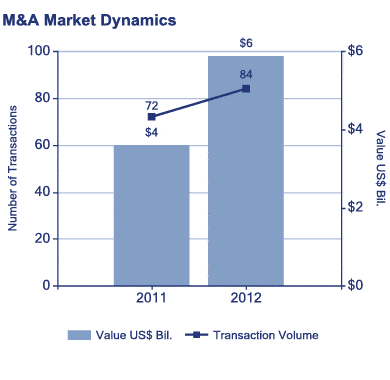2013-09-25 M&A Opportunities in the GRC Market
- Send To
Share:
Introduction
As the U.S. economy continues to recover, many companies are beginning to shift their focus away from survivability and towards increasing their corporate risk management programs. Some of the problems associated with the financial crisis could have been mitigated if effective risk management solutions had been implemented. In order to hedge against unforeseen future risks, companies are beginning to more comprehensively assess their risk management and compliance needs.
The Governance, Risk, and Compliance (GRC) market currently consists of vendors offering fragmented products on different systems. Firms are facing an increasing number of legal and regulatory requirements, resulting in a fragmentation of their reporting services. This can lead to a business process that silos off various risks and data. GRC vendors are working to fix this problem by adding content and combining their package offerings, thereby enabling them to provide a holistic solution for their clients that measures and reports on a wide range of risk factors.
Two-Year M&A Market Overview
Berkery, Noyes & Co. LLC (BNC) has been tracking GRC transactions for over two decades. We recorded 156 GRC mergers and acquisitions (M&A) from the beginning of 2011 through the end of 2012. This accounted for an estimated $9.85 billion in deal value. GRC M&A volume improved 17% on a year-to-year basis. Upon further inspection, 82% of GRC transactions in 2012 were completed by strategic acquirers. Deal value increased 63% during the last twelve months, totaling approximately $6 billion for the year. This was due in part to Goldman Sachs Capital Partners and Advent International Corporation’s acquisition of TransUnion LLC, for $3.20 Billion.
Private equity buyers represented 60% of value but were responsible for just 23% of transaction volume between 2011 and 2012. Nonetheless, the most active acquirer during this timeframe was The Riverside Company, which completed six GRC transactions. Four of these occurred in 2012. Meanwhile, Wolters Kluwer and Experian were some of the most acquisitive strategics in the space.
Median revenue and EBITDA multiples have also been on the rise (see graph below). During the last two years, the median revenue multiple increased from 2.7x to 3.2x, while the median EBITDA multiple improved from 16.0x to 17.5x.
Other Key GRC Trends
There are several other factors with the potential to drive demand in the GRC space. This includes:
-
Creating a consistent process for risk assessment. In this way, all groups are measuring and assessing risks in a unified manner. This involves first establishing a set of consistent policies and procedures within an organization, thereby allowing management to act within a defined set of parameters.
-
Increasing governance metrics. Quantitatively showing risk inputs to upper level managers and giving them a breadth of information is important in order to determine the right course of action. The goal is to have a system that can prioritize risks and enable executives to allocate their efforts and resources to the areas that are going to have the biggest business impact.
-
Streamlining the decision making process. The focus now is on integrating technology and content across business functions, rather than relying on an ad-hoc corporate compliance system.
-
Implementing services through web2.0 and cloud computing. This allows content to be interconnected with leading providers of legal and regulatory content in a unified setting.
-
Providing a broader range of information. Clients want to be kept informed about the global risks associated with their industry, not just those pertaining specifically to their business.
Conclusion
The GRC market should continue to expand with a recovering economy. Many companies are already placing more of an emphasis on corporate governance and risk management in their day-to-day operations. This could allow for further consolidation as large GRC vendors make acquisitions to supplement their offerings. Others might be encouraged to enter the market, which could result in greater acquisition activity down the line. At the same time, some smaller companies might seek to merge in order to compete with the larger players.
ABOUT PETER OGNIBENE
Peter Ognibene is a managing director in the Financial Technology Group at Berkery Noyes. He has managed more than 100 sell-side and buy-side transactions during his career. Peter holds a BA from Syracuse University and an MBA from New York University.
ABOUT BERKERY NOYES
Founded in 1980, Berkery Noyes is an independent investment bank that provides M&A advisory and financial consulting services to middle market companies in the information and technology industries. The firm offers skilled transaction management to publicly traded and privately held businesses and private equity groups in both sell-side and buy-side transactions. Berkery Noyes has managed over 500 transactions, ranging from several million to more than four billion dollars in value.



